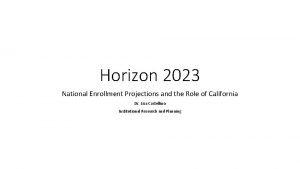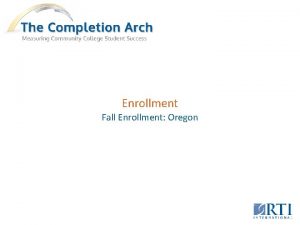Horizon 2023 National Enrollment Projections and the Role






- Slides: 6

Horizon 2023 National Enrollment Projections and the Role of California Dr. Lisa Castellino Institutional Research and Planning

Projected percentage change in the number of public high school graduates by state: School years 2009 -10 through 2022 -23 New Hampshire Washington California’s growth will be somewhat slower than neighboring western states. Montana North Dakota Oregon Idaho South Dakota Wyoming Nebraska Nevada Utah Colorado California Arizona Hawaii New Mexico Minnesota Vermont Wisconsin New York Michigan Pennsylvania Iowa Louisiana a rid Flo <5% lower >=5% lower Rhode Island Connecticut New Jersey Ohio Delaware West Indiana Virginia Kansas Virginia Maryland Missouri Kentucky North Carolina Tennessee South Oklahoma Arkansas Carolina Mississippi Georgia Alabama Alaska <5% higher Mass Illinois Texas >=5% higher Maine Summary: *Decrease 10% between 09 -10 and 22 -23 in the Northeast *Decrease 8% in the Midwest *Increase 9% in the South *Increase 5% in the West Looking ahead, the West will continue to see growth in high school graduates while the Northeast will continue to see declines.

Projected numbers for enrollment in PUBLIC 4 -year postsecondary degree-granting institutions 10, 000 9, 000 8, 896 9, 020 9, 120 8, 345 8, 443 8, 551 8, 668 8, 790 4, 662 4, 737 4, 812 4, 893 4, 971 5, 039 5, 117 5, 176 3, 682 3, 705 3, 739 3, 776 3, 818 3, 857 3, 903 3, 944 Enrollment (in thousands) 7, 000 6, 000 5, 000 4, 000 3, 000 By 2022, Women are still expected to outpace men in enrollments in both number and percent change. 11% Female, 7% Male. 2, 000 1, 000 0 2015 2016 2017 2018 Total 2019 M F 2020 2021 2022

Projected numbers for bachelor’s degrees conferred by ALL postsecondary degree-granting institutions: Gender 815, 000 1, 198, 000 2022 2, 012, 000 807, 000 1, 180, 000 2021 1, 986, 000 798, 000 1, 160, 000 2020 1, 958, 000 792, 000 1, 143, 000 2019 1, 934, 000 786, 000 1, 127, 000 2018 1, 913, 000 783, 000 1, 113, 000 2017 1, 895, 000 782, 000 1, 100, 000 2016 1, 882, 000 779, 000 By 2022, Women are still expected to outpace men in degree conferrals in both number and percent change. 11% Female, 5% Male. 1, 082, 000 2015 1, 861, 000 0 men 500, 000 women total 1, 000 1, 500, 000 Number of Bachelor’s Degrees Conferred 2, 000 2, 500, 000

Projected numbers for enrollment in ALL postsecondary degree-granting institutions: Ethnicity 30, 000 By 2022, the number of Hispanic degree conferrals is projected to increase by 20%, while Black, Non-Hispanic is projected to increase by about 16% 25, 000 Enrollment (in thousands) 20, 000 15, 000 13, 099 13, 191 13, 249 13, 393 13, 492 12, 913 12, 948 13, 010 1, 337 1, 345 1, 355 1, 369 1, 385 1, 400 1, 398 1, 400 3, 119 3, 220 3, 321 3, 423 3, 526 3, 624 3, 697 3, 757 3, 391 3, 487 3, 581 3, 666 3, 743 3, 817 3, 886 3, 940 2015 2016 2017 2018 2019 2020 2021 2022 10, 000 5, 000 0 Black Hispanic Asian/Pacific Islander Alaskan Native White

Fastest Growing Occupations to 2022 Requiring a Four-Year Degree: Percent Change 2012 -2022 United States 0% 5% 10% 15% 20% 25% 30% 35% 40% 45% 50% 46% Interpreters and Translators Information Security Analysts Meeting, Convention, and Event Planners Market Research Analysts and Marketing. . . Geographers Personal Financial Advisors Operations Research Analysts Biomedical Engineers Cost Estimators Actuaries Petroleum Engineers Computer Systems Analysts Medical and Health Services Managers Mental Health and Substance Abuse Social. . . Software Developers, Applications Logisticians Athletic Trainers Dietitians and Nutritionists Social and Community Service Managers Credit Counselors 37% 33% 32% 29% 27% 27% 26% 26% 25% 23% 23% 22% 21% 21% 0% Foresters Biomedical Engineers Information Security Analysts Market Research Analysts and Marketing. . . Interpreters and Translators Operations Research Analysts Cartographers and Photogrammetrists Soil and Plant Scientists Actuaries Meeting, Convention, and Event Planners Cost Estimators Logisticians Management Analysts Environmental Scientists and Specialists, Includi. . . Software Developers, Applications Computer Systems Analysts Environmental Engineers Agents and Business Managers of Artists, . . . Software Developers, Systems Software Training and Development Specialists 10% 20% California 30% 40% 50% 43% 40% 38% 37% 36% 35% 33% 32% 32% 30% 29% 27% 25% 24% 24% 60%










